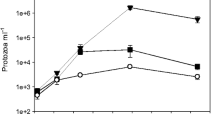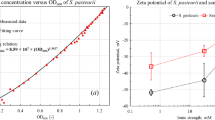Abstract
Land disposal of treated human and animal effluent through pumice sand soils is a common practice around Rotorua, in the central North Island of New Zealand. There is increasing concern about the possibility of contamination of shallow pumice sand aquifers associated with this practice. In this study, we investigated the transport and attenuation of F-RNA bacteriophages and Escherichia coli in saturated pumice sand aquifer media using a field tracing experiment, and laboratory batch and column studies. The influence of dissolved organic carbon on microbial transport was also investigated by conditioning the 18 cm-long column with ultrafiltered sewage. The CXTFIT curve-fitting program was used to model the experimental data and to determine transport and attenuation parameters. Batch studies showed more than 90% adsorption of both microbial indicators onto pumice sand. High mass removal of microbial indicators was shown in the field (>99% for phage MS2 and E. coli at 2 m down gradient of the injection well; not detected at 6 m) and in the ‘clean sand’ column (65% for phage MS2 and 90% or E. coli). These results suggest that uncontaminated pumice is an effective sorbent capable of retaining microbial contaminants due to high surface area and porosity. However, in the column, with additional dissolved organic carbon, phages showed a progressive reduction in mass removal and retardation between experiments (93%, 75%, and 63% removal; retardation factor: 3.5, 2.5 and 1.2). This suggests that the organic matter competed with phages for the sorption sites, thus promoting phage transport. As a result, viral transport rates may be significantly greater in contaminated compared with uncontaminated pumice sand aquifers.







Similar content being viewed by others
References
Aislabie, J., Smith, J. J., Fraser, R., & McLeod, M. (2001). Leaching of bacterial indicators of faecal contamination through four New Zealand soils. Australian Journal of Soil Research, 39, 1397–1406.
Akbal, F. (2005). Adsorption of basic dyes from aqueous solution onto pumice powder. Journal of Colloidal and Interface Science, 286, 455–458.
American Public Health Association (APHA) (1998). Standard methods for the examination of water and wastewater (20thn.nd ed.). Washington, D.C: American Public Health Association.
Brusseau, M. (1995). The effect of nonlinear sorption on transformation of contaminants during transport in porous media. Journal of Contaminant Hydrology, 17, 277–291.
Close, M. E., Pang, L., Magesan, G. N., Lee, R., & Green, S. R. (2003). Field study of pesticide leaching in an allophanic soil in New Zealand. 2: Comparison of simulations from four leaching models. Australian Journal of Soil Research, 41, 825–846.
Dann, R., Wall, K., Flintoft, M., Pang, L., & Close, M. (2007) Assessment of hydraulic properties and microbial transport in pumice sand aquifers near Rotorua. Institute of Environmental Science and Research, Technical Report No. CSC 0704.
Debartolomeis, J., & Cabelli, V. J. (1991). Evaluation of an Escherichia coli host strain for enumeration of F male-specific bacteriophages. Applied and Environmental Microbiology, 57(5), 1301–1305.
Flemming, H. (1995). Sorption sites in biofilms. Water Science and Technology, 32(8), 27–33.
Ginn, T. R., Wood, B. D., Nelson, K. E., Scheibe, T. D., Murphy, E. M., & Clement, T. P. (2002). Processes in microbial transport in the natural subsurface. Advances in Water Resources, 25, 1017–1042.
Goyal, S. M., & Gerba, C. P. (1979). Comparative adsorption of human enteroviruses, simian rotavirus and selected bacteriophages to soil. Applied and Environmental Microbiology, 38(2), 241–247.
Havelaar, A. H., van Olphen, M., & Drost, Y. (1993). F-specific RNA bacteriophages are adequate model organisms for enteric viruses in fresh water. Applied and Environmental Microbiology, 59(9), 2956–2962.
Jin, Y., Yates, M. V., Thompson, S. S., & Jury, W. A. (1997). Sorption of viruses during flow through saturated sand columns. Environmental Science and Technology, 31, 548–555.
Johnson, W. P., Blue, K. A., Logan, B. E., & Arnold, R. G. (1995). Modelling bacterial detachment during transport through porous media as a residence-time-dependant process. Water Resources Research, 31, 2649–2658.
Juhna, T., Klavins, M., & Eglite, L. (2003). Sorption of humic substances on aquifer material at artificial recharge of groundwater. Chemosphere, 51, 861–868.
Katz, A. J., & Thompson, A. H. (1986). Quantitative prediction of permeability in porous rock. Physical Review B, 34(11), 8179–8181.
Lance, J. C., & Gerba, C. P. (1984). Effect of ionic composition of suspending solution on virus adsorption by a soil column. Applied and Environmental Microbiology, 47(3), 484–488.
Matthess, G., Pekdeger, A., & Schroeter, J. (1988). Persistence and transport of bacteria and viruses in groundwater: A conceptual review. Journal of Contaminant Hydrology, 2(2), 171–188.
McLeod, M., Aislabie, J., Smith, J., Fraser, R., Roberts, A., & Taylor, M. (2001). Viral and chemical tracer movement through contrasting soils. Journal of Environmental Quality, 30, 2134–2140.
Milner, D. M., Cole, J. W., & Wood, C. P. (2002). Asymmetric, multiple-block collapse at Rotorua Caldera, Taupo Volcanic Zone, New Zealand. Bulletin of Vulcanology, 64, 134–149.
Pang L, Close M. E., & Sinton L.W. (1996). Protection zones of the major water supply springs in the Rotorua District. Institute of Environmental Science and Research, Technical Report No. CSC 96/7.
Pang, L., & Close, M. (2001). A field tracer study of attenuation of atrazine, hexazinone and procymidone in a pumice sand aquifer. Pest Management Science, 57, 1142–1150.
Pang, L., Close, M., Goltz, M., Noonan, M., & Sinton, L. (2005). Filtration and transport of Bacillus subtilis spores and the F-RNA phage MS2 in a coarse alluvial gravel aquifer: Implications in the estimation of setback distances. Journal of Contaminant Hydrology, 77, 165–174.
Pang, L., Close, M., Goltz, M., Sinton, L., Davies, H., Hall, C., et al. (2003). Estimation of setback distances based on transport of E. coli and F-RNA phages. Environment International, 29, 907–921.
Pieper, A. P., Ryan, J. N., Harvey, R. W., Amy, G. L., Illangasekare, T. H., & Metge, D. W. (1997). Transport and recovery of bacteriophage PRD1 in a sand and gravel aquifer: Effect of sewage-derived organic matter. Environmental Science and Technology, 31, 1163–1170.
Powelson, D. K., Simpson, J. R., & Gerba, C. P. (1991). Effects of organic matter on virus transport in unsaturated flow. Applied and Environmental Microbiology, 57(8), 2192–2196.
Sinton, L. (1980). Two antibiotic resistant strains of Escherichia coli for tracing the movement of sewage in groundwater. New Zealand Journal of Hydrology, 19, 119–130.
Sinton, L. W., Braithwaite, R. R., Hall, C. H., Pang, L., Close, M. E., & Noonan, M. J. (2005). Tracing the movement of irrigated effluent into an alluvial gravel aquifer. Water, Air and Soil Pollution, 165, 277–291.
Sinton, L. W., Finlay, R. K., Pang, L., & Scott, D. M. (1997). Transport of bacteria and bacteriophages in irrigated effluent into and through and alluvial gravel aquifer. Water, Air and Soil Pollution, 98, 17–42.
Sinton, L. W., Noonan, M. J., Finlay, R. K., Pang, L., & Close, M. (2000). Transport and attenuation of bacteria and bacteriophages in an alluvial gravel aquifer. New Zealand Journal of Marine and Freshwater Research, 34, 175–186.
Smith, M. S., Thomas, G. W., White, E. E., & Retonga, D. (1985). Transport of Escherichia coli through intact and disturbed soil columns. Journal of Environmental Quality, 14, 87–91.
Taylor, R., Cronin, A., Pedley, S., Barker, J., & Atkinson, T. (2004). The implications of groundwater velocity variations on microbial transport and wellhead protection – Review of field evidence. FEMS Microbiology Ecology, 49, 17–26.
Thompson, S. S., Flury, M., Yates, M. V., & Jury, W. A. (1998). Role of air-water-solid interface in bacteriophage sorption experiments. Applied and Environmental Microbiology, 64(1), 304–309.
Toride, N., Leij, F.J., & van Genuchten, M. Th. (1995). The CXTFIT code for estimating transport parameters from laboratory or field. Version 2.0. US Department Agriculture, Research Report No. 138.
Wilson, L. G., Gerba, C. P., Bolton, M. W., & Rose, J. B. P. (1984). Subsurface transport of urban runoff pollutants, in N. N. Durham & A. E. Redelfs (Eds.), Proceedings of the Second International Conference on Groundwater Quality Research. University Printing Services, Oklahoma State University, Stillwater, pp. 158–160.
Wood, W. W., & Erlich, G. G. (1978). Use of baker’s yeast to trace microbial movement in ground water. Ground Water, 16, 398–403.
You, Y., Vance, G. F., Sparks, D. L., Zhuang, J., & Jin, Y. (2003). Sorption of MS2 bacteriophage to layered double hydroxides: effects of reaction time, pH, and competing anions. Journal of Environmental Quality, 32, 2046–2053.
Acknowledgements
The authors wish to thank Environment Bay of Plenty, for their assistance with site selection, and well installation. We also thank Ngati Whakaue Tribal Lands Trust for allowing the study to be undertaken on their land, Michael Turner and the Department of Applied Mathematics at The Australian National University for providing SEM and X-ray CT data and interpretation, and Ross Hector (ESR), Martin Hawke and the Rotorua Wastewater Treatment Plant Environment Laboratory for technical assistance. This work was funded from the New Zealand Public Good Science Fund (PGSF), administered by the Foundation for Research Science and Technology (FRST) contract C03X0303.
Author information
Authors and Affiliations
Corresponding author
Rights and permissions
About this article
Cite this article
Wall, K., Pang, L., Sinton, L. et al. Transport and Attenuation of Microbial Tracers and Effluent Microorganisms in Saturated Pumice Sand Aquifer Material. Water Air Soil Pollut 188, 213–224 (2008). https://doi.org/10.1007/s11270-007-9537-3
Received:
Accepted:
Published:
Issue Date:
DOI: https://doi.org/10.1007/s11270-007-9537-3




